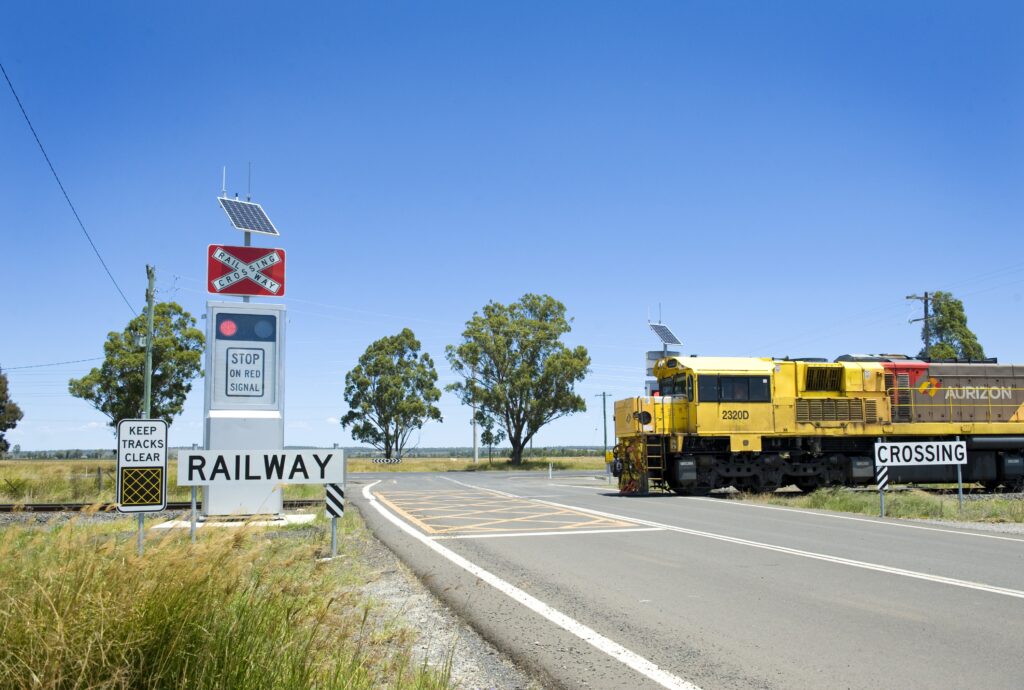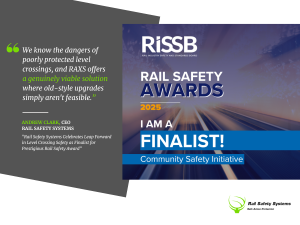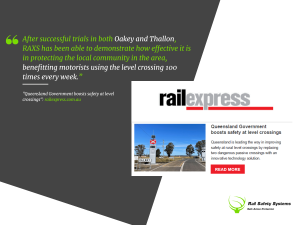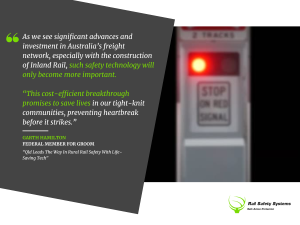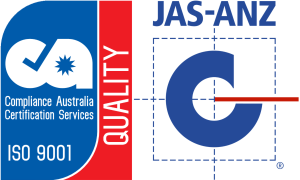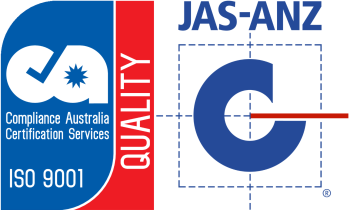A game-changing level crossing protection system specifically designed for rural and remote areas eliminates the use of higher-risk passive signage.
An innovative, Australian-developed active control railway crossing system has just received type approval after completing a successful trial with Queensland Rail.
The high-integrity Rail Safety Systems (RSS) product – named Rail Active Crossing System (RAXS) – meets SIL 3 standards, and is designed to provide rail operators with a cost-effective solution to improve safety at level crossings in rural and remote areas.
The CENELEC SIL, or Safety Integrity Level, is based on the value of risk reduction associated with a Safety Instrumented Function (SIF) protecting against a specific hazardous event. This is the only SIL 3 active system of its kind being used in Australia.
With a combination of wireless technology and solar power, RAXS substantially reduces installation time and cost by removing the need for mains power or cabling requirements that necessitate expensive earthworks.
It features a railway active signage system together with a train detection system, offering significant differentiation compared to conventional active or passive level crossing warning systems.
Safe, clear, compliant regulatory signs provide clear unambiguous visual warnings to road users at all times, regardless of whether the crossing system is active or failed.
This concept of an active/passive sign is highly innovative, and with the assistance of the Department of Transport and Main Roads (DTMR), has now resulted in changes to the Manual of Uniform Traffic Control Devices (MUTCD) standard.
RSS is a systems integrator and manufacturer that leverages existing and proprietary technologies to develop innovative solutions for the rail industry, with a particular focus on providing low-cost rail crossing safety products.
RSS managing director Dagmar Parsons was thrilled to see RAXS finally obtain type approval after an exhaustive development and trial process.
“We are really looking forward to commercialising the system and putting it in to the Australian rail network,” she said.
“A lot of time, effort and money has been invested in developing the system and we are hoping now that the innovation that has gone into the RAXS will be acknowledged by the rail community, and we will see it being adopted as a cost-effective solution to keep communities safe in remote and rural areas.”
Queensland Rail has already committed to a second installation in Thallon upon successful completion of the Oakey trial, while RSS is currently developing a boom gate version of the system for other markets.
“The system is so novel. Nothing like this has been done before in Australia,” Parsons said.
Specialising in the development of high-integrity systems, engineering service provider Acmena was engaged by RSS in 2018 to provide systems assurance and safety management support, playing a role in helping RSS to develop the system and obtain acceptance for trial.
Its consultants were responsible for conducting preliminary product specification and hazard analysis, in addition to performing exhaustive quantitative and qualitative analysis to ensure the RAXS was developed to the SIL 3 standards, while demonstrating its compliance with relevant safety requirements.
“We’ve had to find innovative solutions and approaches to demonstrate that the system is safe and compliant, and Acmena has been instrumental in doing that,” Parsons said.
“They’ve been our trusted advisors and have guided us, while at the same time challenging us to think innovatively and help us find solutions.”
With the boom gate version of the system on the horizon, RSS is in talks with Australian rail operators to obtain certification for RAXS and is also taking interest from organisations in New Zealand, Canada and the United States.
Acmena Director Katherine Eastaughffe said RSS had been clearly committed to good and safe engineering.
“It’s exciting to see this product come to market. These days most rail product development is done overseas, so it is great to see local capability in developing high integrity platforms such as RAXS,” she said.
Safety in sophistication
Responding to the drive by state and federal governments to eliminate incidents and fatalities on level crossings throughout Australia by 2025, RSS formed in 2015 to develop a high-integrity, low-cost ‘active’ control system that would help authorities to attain their zero-harm objective.
Developed specifically for use in rural and remote areas, where most crossings are currently protected by ‘passive’ signage, the RAXS is an innovative, fully autonomous system aimed at providing rail operators with a safer, cheaper alternative to conventional ‘active’ level crossing controls.
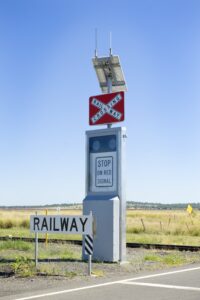
passive mode with newly
approved road sign.
Traditional train detection systems commonly used across Australia and offshore typically rely on mains power, or large-scale solar huts, and require extensive cabling and trenching, on either side of the level crossing, up to one kilometre or more. Installation and maintenance of this solution is expensive when used in rural and regional locations within Australia.
The RSS solution is wireless, self powered and incorporates high degrees of redundancy. The wireless capability eliminates the need for trackside cabling, which in turn lowers the installation costs and ongoing power costs.
The RAXS has demonstrated a capability to detect all classes of rail vehicles, including hi-rail
Designed as a modular solution for deployment across a variety of single and double track configurations, the system is comprised of three interlinked node types.
Central to the system are the twin Active Trackside Road Signs (ATRS). Situated on either side of the tracks, the ATRS units employ a combination of flashing lights (RX5) and signage (RX2) to protect the crossing, with one unit configured to function as the system controller.
Two Active Early Warning Signs (AEWS) can be installed up to 100m from the crossing to advise motorists of changed conditions ahead, while up to four Train Detection Nodes (TDN) can be used to activate the system from up to 1.3km away.
With each node using wireless technology and powered by its own solar array and battery, RAXS has no mains power or cabling requirements that necessitate expensive earthworks, which substantially reduces installation time and cost.
To ensure RAXS would function safely and reliably in the harsh operating environments it is intended for, RSS elected to design the system to stringent CENELEC SIL 3 standards, which requires that it must remain safe in the event of any likely failure. These features are further enhanced by road signage infrastructure which is frangible and has been crash tested at 100kph in a registered crash test facility.
To achieve this standard, both the ATRS and AEWS units feature Fail-to-Safe technology that employs an electromagnetically controlled shutter system to release an RX2 ‘STOP’ sign if a safety-critical fault occurs in one or more nodes.
Automatic deployment of the RX2 signage ensures the crossing remains protected, with the system remaining in its fail-to-safe state until it can be repaired by service crews. Given the response time to fix equipment in remote areas can be significant, this is a vital safety consideration.
In addition to the Fail-to-Safe shutter system, the RAXS employs a combination of sophisticated techniques and technologies to achieve the required safety level, including the use of polled multi-processor architecture in each node to perform continual system diagnostics and prevent the occurrence a single point of failure (SPOF) in the hardware. The system diagnostics are totally integrated with the rail operator’s fault management system to provide real-time information and enable faster service response times.
Similarly, EN50159 Cat 3 encryption, redundant links and frequency hopping broad spectrum signalling to is used protect the wireless network.
As the RAXS was being designed to SIL 3 standards, developing such a complex system and demonstrating that it meets the required criteria for RAMS (EN50126), software (EN50128) and communications (EN50129) would require extensive analysis and testing, in addition to significant expertise and experience in the application of CENELEC standards.
The system was subjected to exhaustive Failure Modes and Effect Analyses (FMEA) at the system-, node- and component levels, analysing more than 500 components in total with over 3400 failure modes considered.
The FMEAs were subsequently used to provide input for detailed Fault Tree Analyses, which were performed to demonstrate that each functional hazard met with its specified Tolerable Hazard Rate.
By working closely with RSS personnel, Acmena’s consultants not only played a key role in helping to develop RAXS 2.0 to SIL 3 standards and subsequently demonstrating that the system’s safety requirements had been met, its extensive analysis also resulted in a number of design improvements being identified and implemented, in addition to the establishment of CENELEC-compliant development processes, which RSS can employ for future products.
The system is currently in operation at a test site near Oakey, Queensland, where local leaders have welcomed the broader roll-out of the technology.
Federal Member for Groom, Garth Hamilton, said it was an affordable, safe solution “that will go a long way to saving lives on regional rail intersections”.
“In tight knit communities like Oakey, the loss of any life is felt extremely deeply, so we should take every step to stop tragedies on the track before they occur,” he said.
“As we see significant advances and investment in Australia’s freight network, especially with the construction of Inland Rail, such safety technology will only become more important.”.
Andy Turnbull, who leads business development for Rail Safety Systems, said the purpose was to keep people safe when travelling on rural and remote roads and rail.
“The type approval certification enables that in Queensland and we hope many more States in the near future,” he said.
THE REGIONAL AUSTRALIA LEVEL CROSSING SAFETY PROGRAM
The RSS product trials are timely, in the wake of the Federal Government’s transformative $180.1 million regional level crossing safety program.
The proposed multi-pronged approach covering upgrades, education, data collection and research will for the first time maximise industry and community collaboration in the pursuit of less incidents, accidents and deaths.
The program includes:
- $160 million for upgrades to level crossings
- $6.5 million to deliver a national level crossing safety education and awareness campaign
- $5 million to support research into and trials of new level crossing technologies and safety measures
- $2 million for improved data collection and risk assessment for level crossings.
This article was originally published in Rail Express Magazine, Issue 3 – May 2022.

